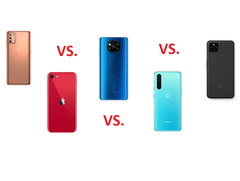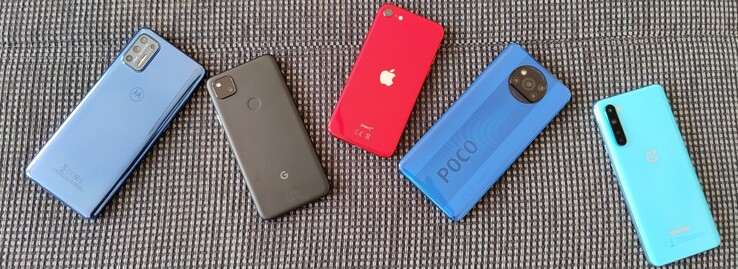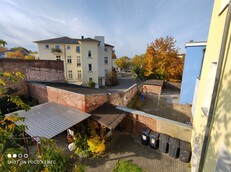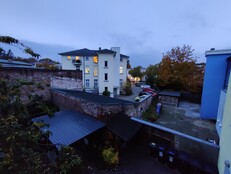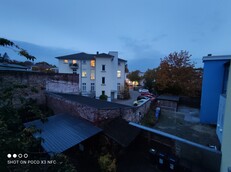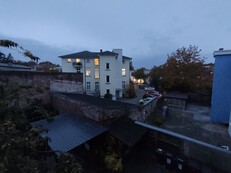We already compared camera systems in mid-range Android smartphones in the first half of this year, but now it is time for another camera test in the mid-range space. We shall test wide-angle, ultra wide-angle, zoom and front-facing camera performance in daylight and at night.
All smartphones have a similar price, with the Apple iPhone SE 2020 having the highest tag (€400-~$474) and the Poco X3 NFC the lowest (€210-~$249).
We test cameras in different lighting conditions and environments.
Camera systems of the mid-range smartphones
When it comes to camera setups, our test candidates could not be more different. While the Google Pixel 4a and the iPhone SE 2020 feature a single camera, the remaining Android competitors rock quad-camera systems.
There is also a lot of variation in terms of resolution. There is a 50-megapixel difference between the Pixel 4a with a 12-MP shooter and the Poco X3 NFC with a 64-MP image sensor. However, because of tetracell (4-in-1) pixel binning, the standard photographs that the Poco X3 takes have a similar resolution.
We used the latest available software for this camera test. The resolutions of test images are the following: Pixel 4a (12.2 MP), OnePlus Nord (12 MP), Poco X3 (16 MP), Moto G9 Plus (16 MP), iPhone SE 2020 (12 MP).
| Google Pixel 4a | OnePlus Nord | Poco X3 NFC | Motorola Moto G9 Plus | Apple iPhone SE | |
|---|---|---|---|---|---|
| Camera Setup (back) | 12.2 MPix (f/1.7) | 48 MPix (f/1.75) + 8 MPix (f/2.25, ultra wide-angle) + 2 MPix (f/2.4, macro); 5 MPix (f/2.4, depth sensor) | 64 MPix (IMX682, f/1.9) + 13MPix (ultra wide-angle, f/2.2) + 2MPix (macro, f/2.4) + 2MPix (depth sensor, f/2.4) | 64 MPix (ƒ/1,8) + 8 MP (ƒ/2,2, ultra wide-angle) + 2 MP (ƒ/2,2, macro) +2 MP (ƒ/2,2, depth sensor) | 12 MPix (f/1.8) |
| Camera setup (front) | 8 MPix (f/2.0) | 32 MPix (f/2.45)+ 8MP (f/2.45, ultra wide-angle) | 20 MPix (f/2.2) | 16 MPix (f/2.0) | 7 MPix (f/2.2) |
| Software | RP1A.201005.006 | AC2003_14_200926 | 12.0.4.0 | QPA30.19-Q3-32-21 | 14.1 |
Daylight Photography with Smartphone Cameras
In this camera test, we used all smartphones in standard, portrait and night mode (when available). These modes have different names in different camera applications. We used default camera settings. To make comparisons between different smartphones easier, we included all test images at full resolution in this article.
In portrait mode, there is quite a bit of variation between different devices. However, all mid-range smartphones with a depth sensor produce portrait shots that are roughly on the same level—the iPhone SE 2020 being a notable exception. The iPhone SE can only take portrait shots with people in the frame, which proves to be quite limiting. The iPhone does not offer an Aperture
mode, unlike Huawei smartphones.
The Poco X3 and the Moto G9 Plus take good shots in portrait mode. However, the Poco X3 offers a slightly better white balance. Both smartphones blur the background well and have good edge detection. The OnePlus Nord also offers a very good colour reproduction, but it produces a subpar Bokeh effect because it struggles with edge detection, which is why parts of the plush kitten are blurred. The Pixel 4a has no issues with exposure, but it has some trouble with correctly applying the Bokeh effect. This is why the portrait shot taken with the 4a appears somewhat unnatural.
Howbeit, when it comes to photographs without the Bokeh effect, the Pixel 4a does a very good job. Just like the iPhone SE 2020, it produces sharp, colourful pictures. Both the Pixel 4a and the iPhone SE capture the most detail in our shots of the fruit basket. The Google smartphone, however, is the best at preserving detail. The Moto G9 Plus and the OnePlus Nord also produce sharp images, but they struggle with exposure. The Poco X3 had some issues with focusing on close objects.
However, the Poco X3 produces sharp, colourful and well-exposed photographs under good lighting conditions as our photo of the pedestrian underpass demonstrates. Here, we like the Moto G9 Plus and the Poco X3 best, because pictures taken with the iPhone SE and the Pixel 4a appear somewhat blurry. The OnePlus Nord produces well-exposed images, but the contrast is off and the level of sharpness could have been higher.
Under somewhat poorer lighting conditions, as in our photograph of the book shelf, the iPhone SE falls behind in terms of overall sharpness. However, the Android-based competitors exhibit a higher level of sharpness variance within images, especially at the edges. The Poco X3 struggles most with exposure here.
The zoom performance is very poor, because none of the smartphones in this camera test have a dedicated telephoto lens. What is quite surprising, though, is that the cheapest smartphone in this comparison was able to deliver the best results—at least in some areas. The text that the sign bears is most readable in the picture captured by the Poco X3. Photos taken with other mid-range smartphones appear either very pixilated (iPhone SE) or very blurry (Pixel 4a).
The iPhone SE and the Pixel 4a do not feature an ultra wide-angle lens, which is why this discipline is not covered extensively.
We like the ultra wide-angle shots produced by the OnePlus Nord best, because they are the most punchy and colour-accurate. The images taken with the Poco X3 are marred by processing errors and appear less sharp when compared to the OnePlus Nord. Nevertheless, the Xiaomi smartphone produces very beautiful ultra wide-angle shots under good lighting conditions. The ultra wide-angle shots captured by the Moto G9 Plus appear undersaturated and oversharpened.
Nighttime photography with smartphone cameras
At night, high-end smartphones produce much better pictures than mid-range devices. Here the iPhone SE does particularly poorly. Apple’s smartphone fails to capture any detail in our photograph of the apartment building. Unlike many Android competitors, it does not offer a night mode. The nighttime photographs taken with the Moto G9 Plus appear so dim as to be completely unusable.
However, the Pixel 4a does quite well in this discipline, thanks to its advanced software. Night shots taken with the Pixel 4a appear less noisy and better-exposed when compared to the rest of the competition. The 4a also produces clearer images than the OnePlus Nord under low-light conditions. The Poco X3 really disappoints, because its night mode does nothing to improve the quality of the photographs.
Under slightly better lighting conditions (street photo), the Phone SE 2020 manages to overcome its issues with focusing and takes passable shots. However, the OnePlus Nord and the Pixel 4a are still far ahead.
We were not able to get any usable night shots when using zoom. The Poco X3 achieved the best results here. However, it was not far head of the Pixel 4a or the OnePlus Nord. The Moto G9 Plus and the iPhone SE produced the worst night shots when using zoom.
When using the ultra wide-angle lens at night, the Moto G9 Plus produces much worse photographs than the Poco X3 and the OnePlus Nord. Here the OnePlus smartphone manages to capture the most detail, even under very poor lighting conditions.
At dusk, the Poco X3 performs about as well as at night. However, the OnePlus Nord does slightly better in semi-darkness, at least in our opinion. The G9 Plus fails to produce usable shots with its ultra wide-angle camera both at night and at dusk. In the photograph of the apartment building taken with the Moto G9 Plus, brickwork appears all smudged up.
Front-facing cameras of the mid-range smartphones
The iPhone SE and the OnePlus Nord produce the best selfies, in our opinion. The Nord comes with two front-facing cameras, which is why it can take ultra wide-angle selfies. Both the Poco X3 and the Pixel 4a produce slightly blurry selfies.
Under poor lighting conditions, the quality of the selfies declines rapidly. Here, the Poco X3 and the Pixel 4a are slightly ahead of the competition. However, the selfies that both mid-range smartphones produce appear quite blurry. Howbeit, the overbrightened selfies of the Oneplus Nord appear even less pleasing.
Under standard indoor lighting conditions, only the Pixel 4a manages to impress. The competitors fail to produce pleasing selfies.
Verdict - Google, the competition has caught up…
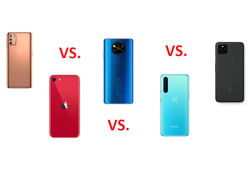
Last year, there was a clear pecking order in our camera comparison of mid-range smartphones. The Pixel 3a from the Mountain View-based US tech giant, which featured nearly the same camera as the 4a model, dominated the rest of the Android competition.
This year, though, tables have turned, but not because of the addition of the iPhone SE 2020, which offers very poor low-light performance. The OnePlus Nord, in particular, gave the Pixel 4a a run for its money, because it features not only a solid main shooter but also a decent ultra wide-angle lens. The Motorola Moto G9 Plus has a bad ultra wide-angle sensor and its main camera performance is also not as strong.
The lower-priced Poco X3 NFC fell behind the Pixel 4a and the OnePlus Nord. However, the overall camera performance of the 210-Euro (~$249) smartphone is not much worse, on the contrary, the Poco X3 produces better photos than more expensive competitors under good lighting conditions.
Google should start to invest into new hardware, because there is not much else it can do with its software.
Note: This verdict is based solely on the camera performance of the smartphones.




